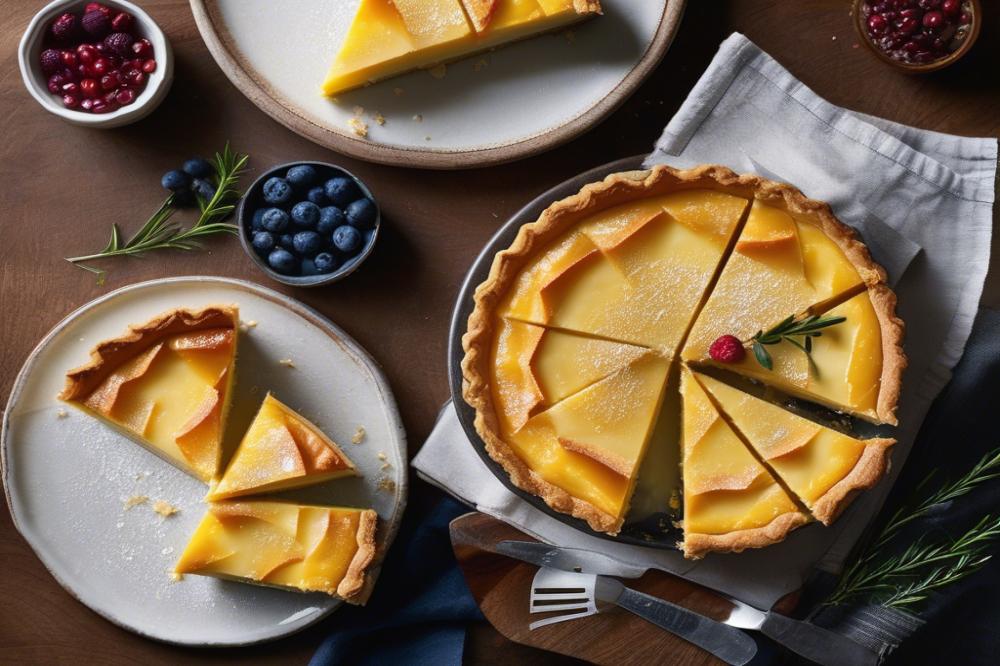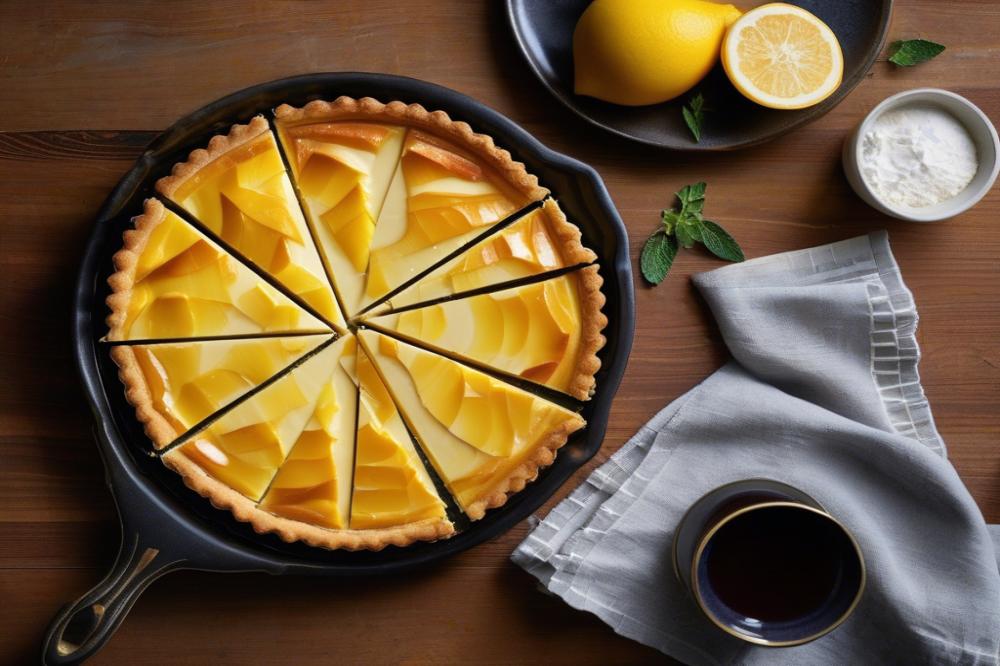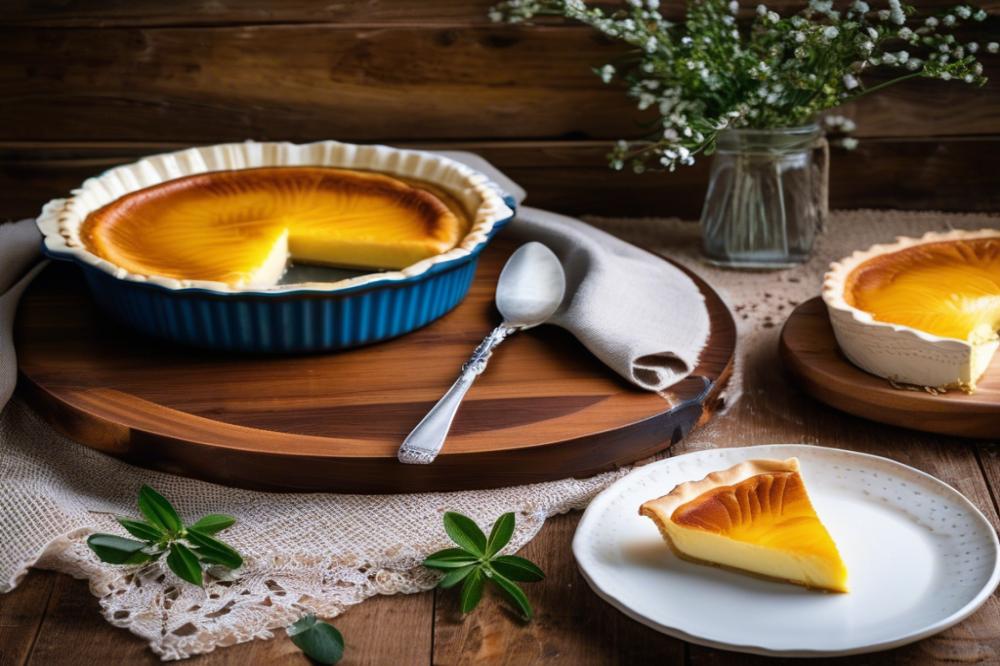Introduction
Galaktoboureko is a classic Greek dessert that captivates the hearts and taste buds of many. This enticing sweet treat features layers of delicate phyllo pastry, embracing a rich custard filling made from milk, semolina, and eggs. The experience of tasting this dish is nothing short of delightful, as it combines a crispy exterior with a smooth, creamy center.
Traditional recipes hold great importance in Greek culture. They connect generations, preserving the flavors and techniques passed down through time. When families gather to bake, they rekindle memories and create new ones with the aroma of cinnamon and sweet syrup wafting through the air.
The texture of this Greek custard Pie is a contrast between the flaky layers and the soft filling. Each bite reveals the harmonious blend of sweetness, enhanced by a drizzle of syrup. The flavors meld beautifully, offering a truly gratifying experience. Enjoying a slice of this dessert feels like a warm embrace, making it a cherished part of many celebrations.
What is Galaktoboureko?


This delicious dessert is a traditional Greek treat known for its rich custard and flaky layers of phyllo pastry. Made with milk and semolina, it provides a creamy texture that contrasts beautifully with the crispness of the dough. The pie is usually soaked in a syrup made from sugar and water, adding a sweet touch that balances the flavors perfectly.
History and Origin of Galaktoboureko in Greek Cuisine
Galaktoboureko has roots that date back centuries in Greece. Many believe it originated during the Byzantine Empire. Over time, the recipe evolved but remained a staple in Greek culinary tradition. Families often enjoy this dessert during holidays and special occasions. The combination of layers, custard, and syrup reflects the warmth of Greek hospitality.
Variations Found in Different Regions of Greece
Regions in Greece often put their own spins on this well-loved dessert. In some areas, bakers might add flavored syrups such as orange or lemon to create a refreshing twist. Others may incorporate nuts for added crunch, enhancing the texture and taste. Each variation highlights local ingredients and cooking styles, making every version a bit different. Regardless of where it comes from, a slice of galaktoboureko always brings a taste of tradition and celebration.
Ingredients for Galaktoboureko


To make this delicious Greek dessert, you will need the following ingredients:
- Phyllo pastry: 1 package (approximately 16 sheets)
- Milk: 4 cups
- Sugar: 1 cup (plus extra for syrup)
- Semolina: 1 cup
- Eggs: 3 large
- Vanilla extract: 1 teaspoon
- Butter: 1 cup (melted)
- Lemon zest: from 1 lemon
- Water: 1 cup (for syrup)
Nutritional Information for Each Ingredient
Here’s a breakdown of the nutritional values for the key ingredients:
- Phyllo pastry:
- Calories: 100 (per 1 sheet)
- Protein: 2g
- Carbohydrates: 22g
- Fat: 3g
- Sugar: 0g
- Milk:
- Calories: 150 (per cup)
- Protein: 8g
- Carbohydrates: 12g
- Fat: 8g
- Sugar: 12g
- Sugar:
- Calories: 774 (per cup)
- Protein: 0g
- Carbohydrates: 200g
- Fat: 0g
- Sugar: 200g
- Semolina:
- Calories: 600 (per cup)
- Protein: 22g
- Carbohydrates: 114g
- Fat: 1g
- Sugar: 0g
- Eggs:
- Calories: 72 (per egg)
- Protein: 6g
- Carbohydrates: 1g
- Fat: 5g
- Sugar: 0g
- Vanilla extract:
- Calories: 12 (per teaspoon)
- Protein: 0g
- Carbohydrates: 1g
- Fat: 0g
- Sugar: 0g
- Butter:
- Calories: 102 (per tablespoon)
- Protein: 0g
- Carbohydrates: 0g
- Fat: 12g
- Sugar: 0g
- Lemon zest:
- Calories: 3 (per teaspoon)
- Protein: 0g
- Carbohydrates: 1g
- Fat: 0g
- Sugar: 0g
- Water:
- Calories: 0
- Protein: 0g
- Carbohydrates: 0g
- Fat: 0g
- Sugar: 0g
Understanding the nutritional components of these ingredients can help you make informed choices. Enjoy your baking journey with this traditional recipe for a sweet custard pie!
Baking Instructions


Start by preparing the custard. Gather the essential ingredients: milk, semolina, sugar, eggs, and vanilla. In a medium saucepan, warm the milk over medium heat. Mix in the sugar and let it dissolve. Once the milk reaches a gentle simmer, slowly whisk in semolina. Stir continuously to avoid lumps. The mixture will thicken in just a few minutes. Remove it from heat, and add vanilla for flavor. Allow this custard to cool slightly.
Next, focus on the phyllo pastry. Unroll the sheets carefully so they don’t tear. You want to work quickly because the dough dries out fast. In a large baking dish, layer some sheets of phyllo pastry at the bottom, brushing each one with melted butter. Use about half the package for this base. The more layers, the better the texture will be. Spread the custard evenly over the layers after you’ve finished with the phyllo.
Now, it is time to add more layers of phyllo on top of the custard. Keep brushing each sheet with butter as you go. This part of the traditional recipe requires skill. Fold any overhanging edges of phyllo inward to seal the pie. With a sharp knife, cut the top layers into diamond shapes to facilitate even baking. Preheat your oven to 350°F (175°C). Once heated, bake the pie for about 45-60 minutes, or until it becomes a lovely golden brown.
While the pie is baking, prepare the syrup. Combine sugar, water, and a squeeze of lemon juice in a small saucepan. Bring this mixture to a gentle boil, letting it simmer for around 10 minutes. Adding the syrup while it’s still hot is crucial. Let the syrup cool a bit. This contrasts nicely with the warm pie.
When you take the Galaktoboureko out of the oven, pour the cooled syrup over the hot dessert. The pie will soak up the syrup perfectly. Wait at least a few hours before slicing. This waiting time allows the flavors to meld together beautifully. For the perfect texture, avoid cutting while it’s too warm.
For tips on achieving an excellent result, remember to keep an eye on your custard. It should be smooth and not lumpy. Also, layering phyllo accurately is important. Each piece contributes to that flaky texture. Regulate oven temperature carefully; overheating can lead to burning. Lastly, patience is key. A little wait can lead to a fantastic result in your final Greek dessert.
Serving and Storing Galaktoboureko Greek Custard Pie


How to Serve the Dessert
Galaktoboureko is best presented with care. Consider cutting it into diamond or square shapes to showcase the layers of phyllo pastry. A light dusting of powdered sugar or a sprinkle of ground cinnamon can add a touch of elegance. Fresh fruit, such as berries or citrus slices, can also serve as colorful garnishes. Serve each piece with a dollop of whipped cream or a scoop of vanilla ice cream for an added indulgence. This Greek dessert shines when placed on a decorative plate, enhancing its visual appeal.
Best Serving Temperature
Serving temperature plays a crucial role in enjoying this dish. Warm or at room temperature is ideal to appreciate the flavors fully. Cold custard may lose some of its charm and creamy texture. If it has just come out of the oven, let it rest for about thirty minutes before serving. This allows the syrup to soak in, making each bite more delightful.
Storage Instructions for Maintaining Freshness
Proper storage is essential to keep your custard pie tasting fresh. If there are leftovers, cover the dessert tightly with plastic wrap or foil. Refrigerate it for up to three days to preserve its flavor and texture. For longer storage, freeze the pie. Wrap it well and place it in an airtight container. When you’re ready to enjoy it again, thaw it in the refrigerator overnight. Reheat lightly in the oven for a few minutes to bring back its original warmth and flavors.
Cultural Significance of Galaktoboureko
This Greek dessert holds a special place in various celebrations and family gatherings. It is not uncommon to see it on tables during weddings, birthdays, and traditional festivals. Baking it symbolizes joy and togetherness. The rich layers of phyllo pastry, combined with a creamy custard made from milk and semolina, create a delight that everyone cherishes.
Hospitality plays a pivotal role in Greek culture. Offering galaktoboureko to guests showcases warmth and generosity. It reflects a dedication to making visitors feel welcome. This dessert often becomes a cherished part of family traditions. When families gather, they may share stories about the preparation of the sweet creation. Recipes passed down through generations further enhance its meaning.
There are many anecdotes tied to this delightful dish. One story often shared is about a grandmother’s secret recipe. Each family member claims they make it better than the others. This friendly competition brings laughter and love to any occasion. Festivals also highlight the dessert. Street vendors may sell it, enticing passersby with the aroma of sweet syrup soaking the flaky pastry.
The importance of this dessert extends beyond mere taste. It captures the essence of Greek life and the love of sharing good food. People bond over the experience of enjoying such a treat. In every bite, there is a connection to heritage. The dedication to maintaining traditional recipes ensures that flavors and feelings remain alive. Every piece of galaktoboureko tells a story of culture and community.
Final Thoughts on a Sweet Tradition
Galaktoboureko is more than just a dessert; it’s a warm reminder of home for many. This custard-filled delight has a rich history in Greek culture, blending flavors and textures that evoke nostalgia. The golden layers of phyllo pastry contrast beautifully with the creamy custard, creating a dish that is as pleasing to the eyes as it is to the palate.
Trying your hand at this traditional recipe can be a rewarding experience. Baking it at home allows you to share the joy of this beloved dessert with friends and family. With each layer you craft and each bite you take, you connect with the culinary traditions that have enjoyed a cherished place on tables for generations.
As you embark on your baking journey, remember that the act of creation brings its own happiness. The simple pleasure of preparing and serving dishes like this can transform your kitchen into a hub of love and laughter. In every slice you share, you’re passing on a piece of culture and joy, making the experience all the more special.
So gather your ingredients, roll out that phyllo pastry, and set aside some time to indulge in this delightful process. The reward is not just tasting the final product, but also creating memories that you can cherish and share for years to come.



